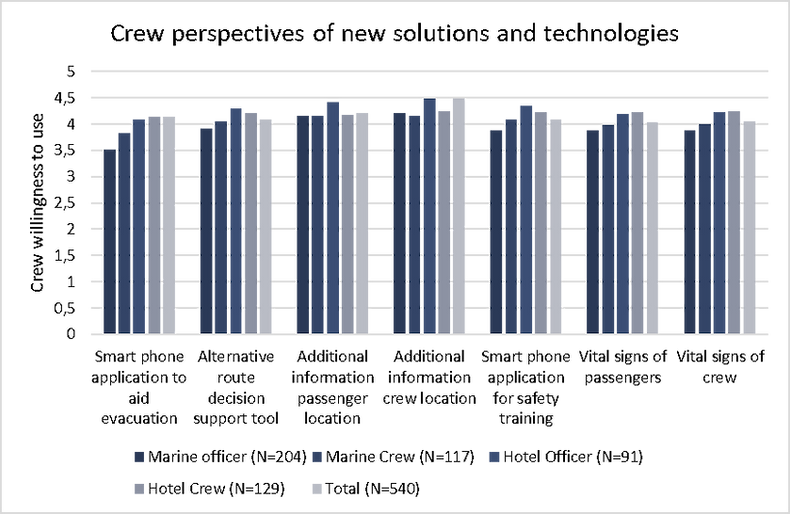SafePASS
NEWS
SafePASS
NEWS
COMING SOON
COMING SOON
NEWS
WP2 System development through a user-centric approach
One of the main objectives of SafePASS project is the provision of stakeholder-driven solutions. This makes the user engagement and participation in the design process crucial for the development and implementation of tools and systems that reflect actual user needs and can improve the performance of evacuation process. As part of WP2 dedicated to the definition of SafePASS Design, User & System Requirements, current practices in ship evacuation processes and regulations were examined and current gaps and needs were identified following a stakeholder-driven approach. Following the Design Thinking Process principles, the SafePASS user requirements were derived from the project’s Description of Action, the analysis of best practices, tools and gaps, the mission and operational requirements and the stakeholder workshops and surveys that were conducted. More specifically, dedicated focus groups were formed, while open discussions, interactive brainstorming sessions and questionnaires were performed during these workshops. The first workshop was conducted onboard the RCCL cruise ship “Jewel of the Seas”, where semi-structured interviews were performed and crew members participated in a facilitated questionnaire survey. The consortium members attended the “Pre-departure Safety Training” for crew and witnessed a full vessel muster drill . In addition, the future requirements for LSA were defined based on the feedback received from external stakeholders during the “Stakeholder Requirements, LSA and Community of Practices Workshop” that took place in January 2020 in Glasgow . Through this process, the user requirements were extracted and summarized in a consolidated list that served as reference matrix for the definition of functional requirements.

Moreover, the definition of user behaviour and scenarios of use is a key factor for the design process, as it can reveal the full potential of SafePASS and can be used as the baseline towards the validation process. For this reason, user models called personas were defined, illustrating how users behave, how they think, what they wish to accomplish and why. Although personas are not real people, they are based on the behaviour and motivations of real people and through their use we can develop and understand our user goals in specific contexts. Ten (10) personas were selected covering the whole range of SafePASS users (passengers and crew) and representing a wide spectrum of demographics. In parallel, six (6) scenarios of use were described based on the outcomes of the stakeholder workshops and the identified gaps of the state-of-the-art analysis, defining characteristics such as the time of the day, the sea state, the location of the vessel and the type of incident. These use cases were correlated with the personas to validate the user requirements and assess their interconnections with SafePASS components.

-
In order to develop move technical solutions that can fulfil the user needs, the user requirements were transformed into functional and non-functional requirements, describing system functionalities and serving as the basis for the subsystems’ development and performance assessment. The functional requirements were also prioritized based on their necessity as Must (minimum performance standards), Should (providing added value to the customer) and Could (nice to have features). Furthermore, relevant system specifications were described, covering the design and technological aspects required for subsystems’ implementation, and Key Performance Indicators (KPIs) were defined. Through this process, a Requirements – Specifications Traceability Matrix has been created, where all functional requirements are cross-correlated with user requirements, use cases and KPIs, depicting also their current status. This traceability matrix has been used during the whole process of component development and implementation to ensure that the system specifications that have been defined are met.

-
In addition, the architecture of the whole SafePASS system was designed, as well as the architecture of each one of its sub-components, in order to provide a concrete and actionable framework for the project’s development phase. Different architectural views were defined, such as physical or logical architecture, in order to depict the various conceptual models of each component and to provide a clear view of its performance. Each component’s behavior and communication were analyzed, along with its interactions with other systems and components. In this way, the structure and behavior of each component were defined, as well as the informational content of the elements that consist the system, the relationships among those elements and the rules governing these relationships.

-
Furthermore, dedicated surveys were administered to passengers and crew members, to enhance user involvement and ensure that SafePASS provides social- and behavioural-driven solutions and technologies that comply with actual end-user needs and preferences. The surveys were administered in collaboration with WP7 as part of the sociotechnical assessment, which included interviews with stakeholders (crew with evacuation responsibilities) and External Advisory Board workshops to ensure a complete systems approach. The surveys set out the SafePASS technologies, along with their functionalities and role in the future evacuation process, and elicited feedback from respondents on their perceptions of the utility of the SafePASS technologies and their willingness to use them. Insights from passengers with access requirements were sought through ENAT (European Network for Accessible Tourism) and other charities and associations. A total of 876 crew members and 215 passengers completed the surveys, and both sets of respondents rated the SafePASS technologies very positively and expressed high rates of willingness to use the proposed tools and systems.


